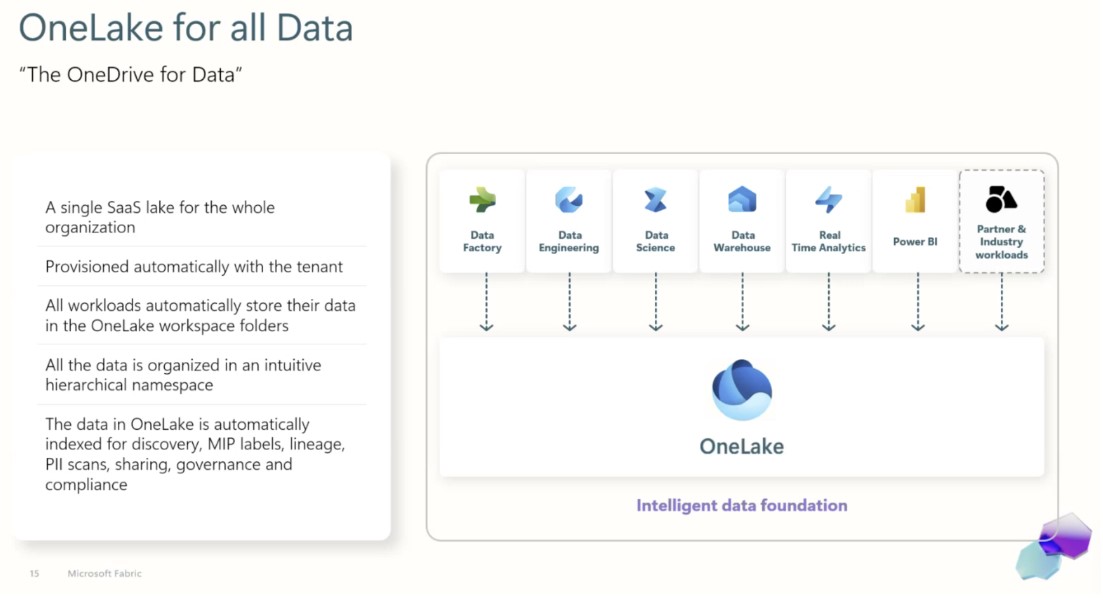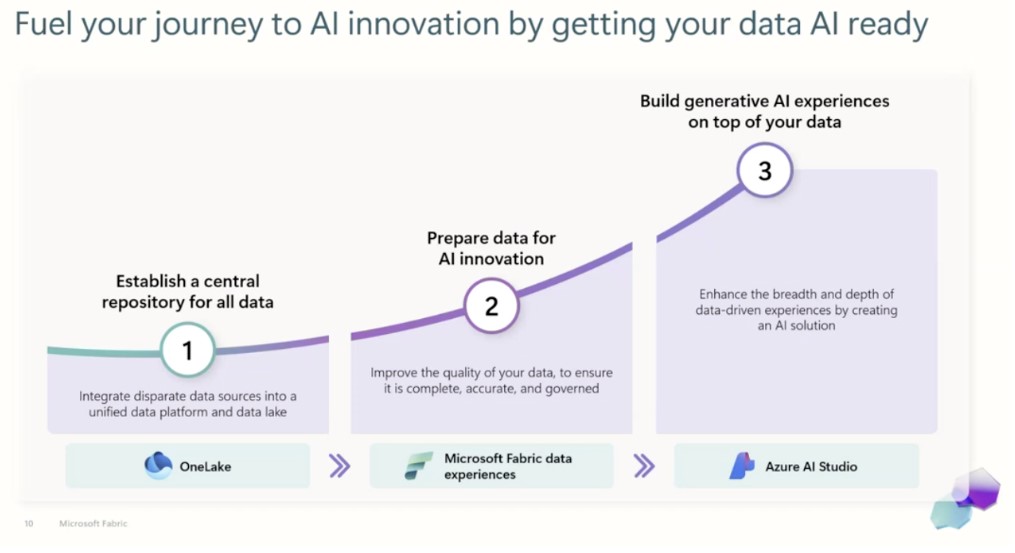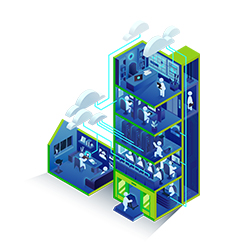Microsoft Fabric offers businesses a comprehensive way to manage and integrate their data. This unified, cloud-based platform combines data engineering, data warehousing, real-time analytics, and AI, providing a streamlined approach to meet modern data needs. With features like OneLake, One Copy, Delta Parquet, Mirroring, and Shortcuts, Fabric simplifies data processes, minimizes redundancies, and prepares organizations for the future of AI.
Here’s an overview of Microsoft Fabric and how it can support efficient data management for your business. For more details, watch the full webinar here.
Introduction to Microsoft Fabric
Microsoft Fabric is a comprehensive, cloud-based data platform designed to bring together data engineering, data warehousing, real-time analytics, and AI in a single environment. Traditionally, these capabilities required separate tools, each with its own setup and maintenance.
Fabric eliminates that complexity, providing a streamlined experience for businesses looking to unify data processes across departments and reduce infrastructure management. By centralizing these functions and integrating advanced security controls like Purview Data Loss Prevention (DLP), Fabric allows organizations to focus on data insights while maintaining strong data governance.
Security at the Core of Microsoft Fabric
Data security is a critical component of effective data management. Microsoft Fabric integrates seamlessly with Microsoft Purview to provide robust security and governance capabilities.
- Purview DLP Policies: These policies help monitor and control the flow of sensitive data within Fabric workspaces, ensuring compliance with organizational and regulatory requirements.
- Sensitive Data Protection: Using sensitivity labels and information types, Purview scans for patterns like credit card numbers or personal identifiers, enforcing restrictions on sharing or transmitting data outside the organization.
- Administrative Control: Administrators can customize notifications, enforce business justifications, and block unauthorized data sharing, reducing the risk of data breaches.
Fabric's security measures extend to its infrastructure, with features like row, column, and object-level security, as well as private endpoints to secure connections to sensitive data sources.
OneLake at the Core of Microsoft Fabric
At the core of Microsoft Fabric is OneLake, described as the "last data lake you’ll ever need." Much like OneDrive for documents, OneLake centralizes data storage within Fabric, ensuring that all data is accessible across various tools and services within the platform. This unified storage solution allows data to be managed from a single source of truth, eliminating redundant data copies and simplifying data governance.

One Copy and Delta-Parquet
OneLake’s efficiency is enhanced by the One Copy approach and the Delta-Parquet storage format. With One Copy, data remains consistent and accessible across all services in Fabric, allowing users to avoid duplicate copies that can create inefficiencies and data silos.
Delta-Parquet, the standardized storage format used for all tabular data by Fabric, enables high-performance data querying and seamless interoperability across tools like Power BI, SQL, and Spark. This approach ensures that data engineers, analysts, and AI models can all work from a single version of the data, promoting consistency and reducing storage costs.
Mirroring and Shortcuts to Simplify Data Integration
Microsoft Fabric includes powerful tools, Mirroring and Shortcuts, to make data integration seamless. These features address common challenges when accessing data from external sources, especially across hybrid environments.
Mirroring allows for a managed replica of databases within Fabric, making data readily accessible without needing to set up complex extraction processes. Shortcuts enable users to link directly to external data sources, such as Amazon S3 or Google Cloud, without moving data from its original location. This approach provides flexibility, allowing businesses to access data from multiple sources without creating redundant copies.
By using Mirroring and Shortcuts, organizations can integrate data from a variety of sources into Fabric while retaining control over where their data is stored.
Bridging the Gap Between On-Premises and Cloud
For organizations operating in a hybrid setup, where data resides both on-premises and in the cloud, Microsoft Fabric offers a flexible solution. Fabric’s connectivity supports on-premises data sources, making it easy to bridge on-premises and cloud data within the same environment. This feature enables organizations to unify their data workflows without disrupting existing systems, creating a smooth transition between on-premises and cloud environments.
Preparing for the Future with AI in Microsoft Fabric
With AI capabilities integrated directly into the platform, Microsoft Fabric is built to help organizations harness the power of artificial intelligence. According to an MIT Sloan Management Study, 87% of businesses believe AI will provide a competitive advantage, and Microsoft Fabric positions organizations to make that leap.
Fabric’s integration with Azure AI Studio allows companies to begin implementing AI solutions today while preparing for future advancements. The platform’s One Copy and Delta Parquet framework ensure that data is AI-ready—secure, structured, and easily accessible for analysis. Additionally, like many other Microsoft solutions, Fabric includes Copilot, a generative AI tool that can accelerate data insights and help users automate tasks within the platform.

Getting Started with Microsoft Fabric
Microsoft Fabric represents a major advancement for organizations seeking to streamline data management, enhance analytics, and prepare for the future of AI. With central data storage through OneLake, tools for seamless data integration like Mirroring and Shortcuts, the flexibility to bridge on-premises and cloud data, and built-in AI capabilities, Fabric can move your business forward.
For a more in-depth look at how Microsoft Fabric can enhance your data operations, watch the full webinar here or contact Long View Systems to learn more about our Fabric in 30 offering.

Subscribe to our newsletter for the latest updates.